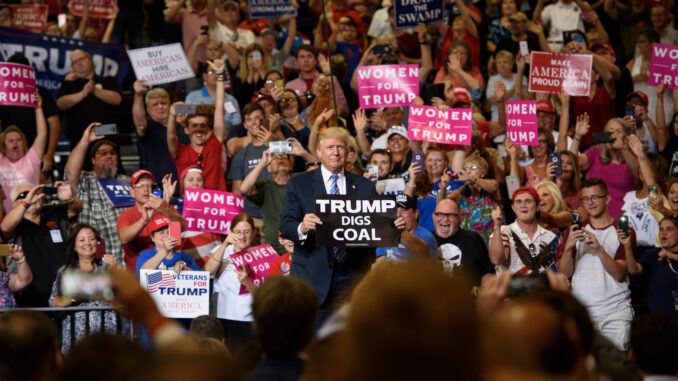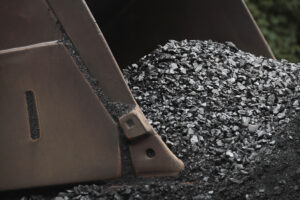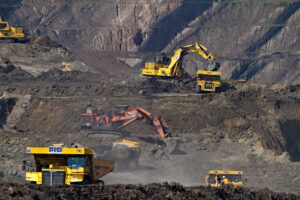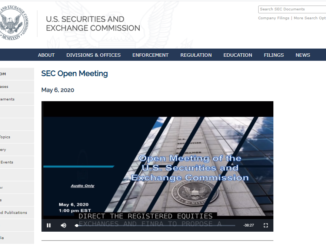
Wilmington, N.C.—The day before the 2016 United States presidential election, the Republican candidate Donald Trump promised a rally at Lackawanna College in Scranton, Pa. if elected President, coal miners would be put back to work.
“To all the people of Pennsylvania I say, we are going to put the miners and the factory workers and the steelworkers back to work,” said Trump to the crowd, which included supporters waving “Trump Digs Coal” signs.

Trump’s appeal to Pennsylvania coal country produced results, as he won the swing state’s 20 electoral votes by less than 50,000 votes. In 2012, Obama won the state by more than 200,000 votes.
Nearly four years later, Trump is telling Pennsylvania voters he fulfilled his promise.
“We’re putting our great coal miners back to work,” he told a Johnstown, Pa. rally on Oct 13.
But has the president kept his promise to revive the “beautiful, clean coal” industry? His record shows he has made an effort to ease regulations on the fossil fuel, but market forces and concerns about pollution and climate change have hampered the results.
In his 2016 campaign, Trump won several key states after he made inroads with many blue collar workers with promises to industries threatened by changing economic trends, including Wisconsin and Pennsylvania.
One of those key states was Pennsylvania, which has seen its once thriving coal mining industry hobbled by a shift away from fossil fuels for energy production. Coal, primarily used to power electrical plants, has been shunned by regulators and utilities in favor of renewable energy or fossil fuels with lower carbon emissions, like natural gas.

Under Obama, the coal industry shed thousands of jobs in states like West Virginia and Pennsylvania as his policies accelerated the adoption of renewable energy sources. The transition has reduced U.S. carbon dioxide emissions, but the shift away from coal also cost thousands of coal miners their jobs.
While Trump has pushed through several measures to help the struggling coal industry, the jobs haven’t come back. However, his efforts have slowed the rate of job loss in the industry.
From an Obama-era peak of 89,700 jobs in January 2012, coal mining employment dropped to around just 50,000 jobs when Trump won the presidency in 2016, according to data from the U.S. Bureau of Labor Statistics.
Since then, more coal mining jobs have been shed, and like most of the economy, the industry was also hit by the coronavirus, as coal mining jobs dropped to a low of 41,900 in April 2020. Some of those jobs have returned, but the projected coal mining employment of 44,500 in September 2020 is still down from the 50,900 coal mining jobs the BLS registered in Trump’s first month in office in January 2017.
Trump began easing Obama’s regulations restricting coal soon after entering office, starting in March 2017 with an executive order that served to “hobble or reverse some of a broad set of climate and clean energy initiatives developed by the Obama administration,” according to a report from the Brookings Institute.
One part of the order the EPA to review and possibly replace the Clean Power Plan, which put greenhouse gas emission restrictions on power plants. The order also reversed the Obama administration’s prohibition on issuing coal mining leases for federal lands.
Then in June 2017, Trump announced that the U.S. would leave the Paris Climate Accord, an international pact which obligated signers to reduce greenhouse gas emissions. The White House said the climate agreement would sap $3 trillion from the economy and cost more than 6 million industrial jobs.
While the hemorrhaging of coal mining jobs appears to have slowed under the Trump administration, energy industry observers still paint a bleak future for the industry.

Most notably, an October report from the International Energy Agency forecast a steep decline in coal usage worldwide, projecting “coal’s share in the 2040 energy mix falls below 20% for the first time since the Industrial Revolution,” the 2020 World Energy Outlook said.
The report cited coal phase-out policies, increased adoption of renewable energy and increased competition from natural gas as responsible for the retirement of 100 gigawatts of coal-fired power generation in the U.S., along with a 75 gigawatt reduction in Europe.
Another report paints an even bleaker picture for the U.S. coal industry, forecasting coal’s percentage of the U.S. power-generation potentially dropping into single digits by 2025. The Institute for Energy Economics and Financial Analysis report titled “Coal Outlook 2020: Market trends are pushing U.S. industry to a reckoning” notes that in 2014, coal supplied 38.6 percent of U.S. electricity needs, but had dropped to 23.4 percent by 2019, three years after Trump’s election.
The bleak outlook for coal has also been reflected in the U.S. stock market. The Dow Jones U.S. Coal Index, which tracks companies in the coal industry, has dived over the past two years. From a high of $82.06 on Sept. 12, 2018, the index closed at $7.50 on Sept. 18, 2020.
“In other words, coal’s importance will continue to decline, as market erosion gains momentum across the industry,” said Dennis Wamsted, an IEEFA analyst/editor and lead author of the report.

However, despite the lackluster growth of the industry under Trump, many in the coal mining industry still strongly stand behind the president and are expressing appreciation for his efforts. One of them, Terry L. Headley of Citizens for Coal, urged supporters of the coal industry to cast their votes for Trump.
“Trump made good on his promises to us in America’s ‘Rust Belt.’ He brought investment back to the United States with lower taxes, and he moved swiftly to end the radicalized regulatory agencies’ reign of terror. Coal employment stabilized, and we actually started to see some of those laid off return to work,” he wrote in August to supporters.
“For America’s coal miners, coal communities and the rest of the Rust Belt … there is no choice. We must re-elect President Trump if we are to stand any chance at all of holding on to our way of life.”
(Edited by Bryan Wilkes and Matt Rasnic)
The post Coal Shrinks Despite Trump Pledge to Halt Slide appeared first on Zenger News.





